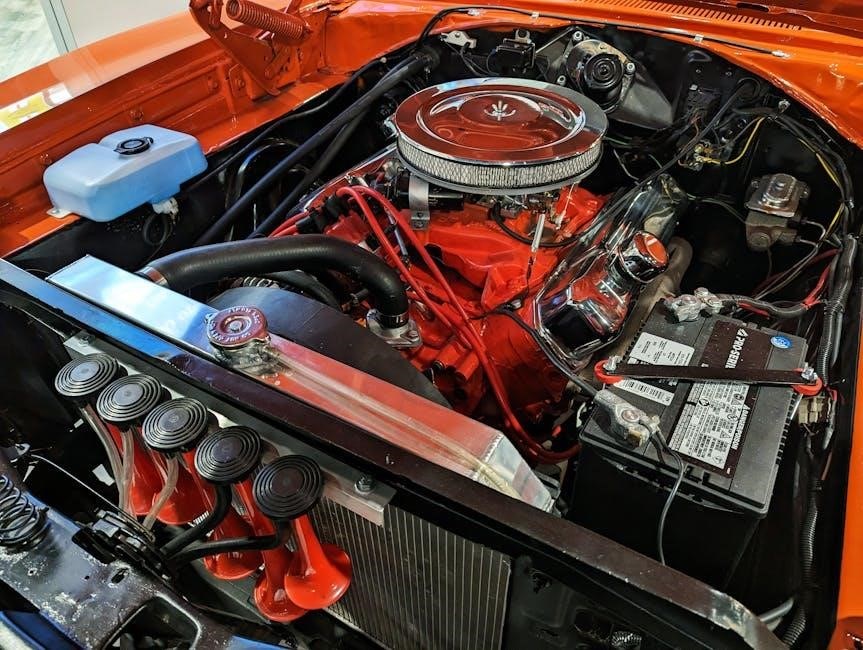1966 Chevelle Big Block Ignition Coil Wiring Diagram: An Overview
The 1966 Chevelle wiring diagram is a crucial resource‚ especially for restoration projects. It outlines the intricate connections within the car’s electrical system. This diagram illustrates the wiring for the ignition system‚ including the coil‚ essential for engine operation and maintenance.
Importance of a Correct Wiring Diagram
A correct wiring diagram is paramount for the safe and efficient operation of a 1966 Chevelle. Faulty wiring can lead to breakdowns and even fires‚ making accurate diagrams vital for both restoration and maintenance. Diagrams ensure all components are connected correctly. They provide the correct wire and their specific locations.
Using the proper wiring diagram is key to understanding how the car’s electrical system functions. It aids in diagnosing problems‚ tracing circuits‚ and making repairs. The diagram also helps when upgrading or modifying the ignition system. It is essential to ensure that all connections are secure and that the correct voltage is delivered to each component.
Investing in a reliable wiring diagram is a smart move for any Chevelle owner or enthusiast. A reliable diagram saves time and prevents costly mistakes. With a correct diagram‚ one can confidently tackle electrical repairs and modifications‚ ensuring the long-term reliability of their classic car.

Identifying Wires on the Ignition Switch
Identifying the wires on the ignition switch is crucial for proper functionality. Common wires include BATT (battery)‚ IGN (ignition)‚ and SOL (solenoid). Correctly identifying each wire ensures the car starts and runs as intended‚ avoiding potential electrical issues.
BATT (Battery) Wire
The BATT wire‚ often red‚ connects directly to the car’s battery‚ providing a constant 12V power source; This wire is essential for all electrical functions‚ even when the ignition is off. It powers circuits like the headlights and some accessories.
Ensuring a solid connection for the BATT wire is critical‚ as a loose or corroded connection can lead to numerous electrical problems‚ including a no-start condition. When troubleshooting electrical issues‚ always check the BATT wire and its connections first.
In a 1966 Chevelle‚ the BATT wire plays a vital role in supplying power to the ignition switch. Without a proper connection‚ the ignition system will not function correctly. The BATT wire ensures a continuous power supply.
When upgrading or replacing the wiring harness‚ pay special attention to the BATT wire. Use a high-quality wire and connectors to ensure long-lasting reliability. A properly functioning BATT wire is fundamental to the overall electrical system.
IGN (Ignition) Wire
The IGN wire‚ typically pink in a 1966 Chevelle‚ provides power to the ignition system only when the ignition switch is in the “on” or “run” position. This wire activates the coil and other components needed for the engine to run. Without a functioning IGN wire‚ the car won’t start or stay running.
The IGN wire is a switched power source‚ meaning it’s only live when the key is turned. It’s a critical part of the ignition circuit‚ supplying the necessary voltage for the spark plugs to ignite the fuel mixture. A break or short in this wire can cause intermittent starting problems or complete engine failure.
When diagnosing ignition issues‚ checking the IGN wire for continuity and proper voltage is essential. Ensure the wire is securely connected to the ignition switch and the coil. A faulty IGN wire can also affect other electrical components that rely on switched power.
Upgrading the ignition system often involves replacing the IGN wire with a heavier gauge wire to handle increased current demands. This can improve the reliability and performance of the ignition system‚ especially with high-performance engines. Proper installation is crucial.
SOL (Solenoid) Wire
The SOL wire‚ typically purple‚ connects the ignition switch to the starter solenoid on a 1966 Chevelle. When the ignition switch is turned to the “start” position‚ this wire sends a signal to the solenoid‚ energizing it and engaging the starter motor to crank the engine. A properly functioning SOL wire is essential for starting the car.
This wire carries current only during the starting process. It signals the solenoid to close the circuit‚ allowing battery power to flow to the starter motor. Any issues with the SOL wire‚ such as corrosion‚ breaks‚ or loose connections‚ can prevent the starter from engaging‚ resulting in a no-start condition.
Troubleshooting starting problems often involves checking the SOL wire for voltage when the key is in the “start” position. A multimeter can be used to verify that the wire is receiving power from the ignition switch. Also‚ inspect the wire and its connections for any signs of damage or corrosion.
Replacing the SOL wire with a new one is a common solution for starting issues related to a faulty wire. Ensure the replacement wire is of the correct gauge and is properly connected to both the ignition switch and the starter solenoid. This ensures reliable starting performance.

Common Wiring Issues and Solutions
Several common wiring issues can plague a 1966 Chevelle‚ particularly in the ignition system. One frequent problem is corroded or loose connections‚ which can impede current flow and lead to starting problems or intermittent engine performance. Regularly inspecting and cleaning connections‚ especially at the ignition coil‚ starter solenoid‚ and ignition switch‚ is crucial.
Another prevalent issue is damaged or frayed wiring due to age or environmental factors. Wires can become brittle and crack‚ causing shorts or open circuits. Replacing damaged sections of wiring or the entire harness is often necessary to ensure reliable operation. Using proper crimping tools and connectors is vital for secure and long-lasting repairs.
Incorrect wiring modifications or splices can also cause problems. Ensure that any aftermarket components or repairs are wired according to the correct wiring diagram. Using the wrong gauge wire or improper splicing techniques can lead to voltage drops‚ overheating‚ or even electrical fires. Consulting a wiring diagram is essential.
Finally‚ issues with the ballast resistor wire can affect ignition performance. A failing ballast resistor wire can reduce voltage to the ignition coil‚ causing weak spark and poor engine running. Testing the ballast resistor wire and replacing it if necessary can restore proper ignition voltage.

Upgrading the Ignition System
Upgrading the ignition system on a 1966 Chevelle‚ especially one with a big block engine‚ can significantly improve performance and reliability. One popular upgrade is switching from the original points-style ignition to an electronic ignition system‚ such as a HEI (High Energy Ignition) distributor. This eliminates the need for regular points adjustments and provides a stronger‚ more consistent spark.
Another option is to install an aftermarket ignition control box‚ such as an MSD unit. These boxes offer features like multiple sparks‚ adjustable rev limits‚ and improved spark timing control‚ leading to enhanced engine performance. However‚ these systems often require a full 12 volts‚ bypassing the original ballast resistor wire.
When upgrading‚ it’s crucial to ensure proper wiring. Using a new wiring harness or carefully modifying the existing one is recommended. Ensure that all connections are secure and properly grounded. Also‚ consider upgrading the ignition coil to a higher-performance unit to complement the new system.
For those seeking maximum performance‚ individual coil-on-plug systems are available. These systems provide the most precise spark control and eliminate the need for a distributor. However‚ they require significant wiring modifications and may necessitate a programmable engine management system. Always consult a wiring diagram.
The Role of the Ballast Resistor Wire
In a 1966 Chevelle with a big block engine‚ the ballast resistor wire plays a crucial role in the ignition system. This wire‚ typically a resistance wire rather than a standard copper wire‚ is designed to reduce the voltage supplied to the ignition coil during normal operation. The purpose is to protect the coil from overheating and potential damage.
During starting‚ when the engine requires a stronger spark‚ the ballast resistor wire is bypassed‚ providing the coil with a full 12 volts from the battery. This ensures a reliable start‚ especially in cold weather. Once the engine is running‚ the voltage drops back down‚ thanks to the resistor wire‚ extending the life of the coil.
If the ballast resistor wire is faulty or bypassed incorrectly‚ the coil can overheat and fail prematurely. Conversely‚ if the wire has too much resistance‚ the engine may be difficult to start or may not run properly. When upgrading the ignition system‚ it is important to understand the function of the ballast resistor wire and whether it is still needed with the new components.
Some aftermarket ignition systems‚ such as HEI distributors‚ require a full 12 volts and do not need the ballast resistor wire. In these cases‚ the wire must be bypassed to provide the necessary voltage. Always consult the manufacturer’s instructions for the specific ignition system being installed.
Troubleshooting Ignition Problems
When experiencing ignition problems in a 1966 Chevelle‚ especially with a big block engine‚ a systematic approach is crucial. Start by checking the basics: ensure the battery is fully charged and the connections are clean and tight. A loose or corroded connection can disrupt the flow of electricity‚ leading to starting issues or a complete failure to start.
Next‚ inspect the ignition coil. Look for cracks or leaks‚ which indicate a failing coil. Use a multimeter to check the coil’s primary and secondary resistance. Compare your readings to the specifications in the wiring diagram or repair manual. An incorrect resistance reading suggests a faulty coil.
Examine the wiring harness for any signs of damage‚ such as frayed wires‚ melted insulation‚ or loose connections. Pay close attention to the ballast resistor wire‚ as it can degrade over time and cause voltage drops. Use a test light or multimeter to verify that the ignition switch is sending power to the coil when the key is in the “on” position.
If the engine cranks but doesn’t start‚ check the distributor. Ensure the distributor cap is not cracked and that the rotor is in good condition. Verify the timing is correct‚ and that the points (if equipped) are properly gapped or the electronic ignition module is functioning correctly. A wiring diagram can be invaluable in tracing the circuit and identifying potential faults.
Finding a Reliable Wiring Diagram PDF
Locating a reliable wiring diagram PDF for your 1966 Chevelle‚ especially one tailored to the big block engine configuration‚ is crucial for any electrical work. Start by exploring online forums dedicated to Chevelle enthusiasts. These communities often have shared resources and experienced members who can point you to trustworthy sources. Look for diagrams that are clear‚ comprehensive‚ and specific to the 1966 model year.
Reputable auto parts retailers and classic car restoration suppliers frequently offer wiring diagrams as part of their product catalogs or as free downloads on their websites. These diagrams are often professionally produced and verified for accuracy. Be wary of generic diagrams that may not accurately represent the specific wiring configuration of your Chevelle.
Consider purchasing a service manual or repair manual specifically for the 1966 Chevelle. These manuals typically include detailed wiring diagrams‚ along with other valuable information for maintaining and repairing your vehicle. Ensure the manual covers the big block engine option‚ as wiring configurations can vary depending on the engine type.
When downloading a PDF‚ verify the source’s credibility and check for reviews or testimonials from other users. A reliable diagram will have clear labeling‚ accurate wire colors‚ and a comprehensive overview of all electrical components. Always cross-reference the diagram with your vehicle to ensure accuracy before beginning any electrical work.
Safety Considerations When Working with Electrical Systems
Working with the electrical system of a 1966 Chevelle‚ especially when dealing with the ignition coil and wiring‚ demands strict adherence to safety protocols. Always disconnect the battery’s negative terminal before commencing any electrical work. This prevents accidental shorts and potential electric shocks. Ensure the ignition is switched off to avoid any unexpected activation of the system.
When inspecting wiring‚ use insulated tools to prevent short circuits. Check for frayed or damaged wires‚ and replace them immediately to eliminate fire hazards. Wear safety glasses to protect your eyes from sparks or debris. If you are unfamiliar with automotive electrical systems‚ seek guidance from a qualified mechanic or electrician.
Be cautious when working around the ignition coil‚ as it can store a high voltage even after the engine is turned off. Avoid touching any exposed terminals or wires. When testing circuits‚ use a multimeter or test light designed for automotive use. Never use household electrical testers‚ as they can damage the vehicle’s electrical system.
If you are replacing wiring harnesses‚ ensure they are properly grounded to the vehicle’s chassis; Poor grounding can lead to electrical malfunctions and potential safety hazards. Double-check all connections to ensure they are secure and properly insulated. Always prioritize safety to prevent injury and protect your classic Chevelle from electrical damage.

Resources for 1966 Chevelle Wiring
Finding reliable resources for 1966 Chevelle wiring‚ especially for the big block ignition coil‚ is crucial for restoration and repair. Online forums dedicated to Chevelles‚ like Team Chevelle‚ are invaluable for accessing shared knowledge and troubleshooting advice from experienced owners. These forums often contain threads with detailed discussions and wiring diagrams posted by members.
Reputable parts suppliers‚ such as Eckler’s Chevelle & Malibu‚ offer reproduction wiring harnesses and diagrams that adhere to GM specifications. These harnesses ensure correct wire colors and connections‚ simplifying the restoration process. Additionally‚ companies like Painless Performance provide aftermarket wiring solutions and fuse blocks tailored for classic cars.
Original GM service manuals and wiring diagrams‚ often available in PDF format through online archives like the GM Heritage Center‚ offer comprehensive information on the 1966 Chevelle’s electrical system. These documents provide detailed schematics and color codes essential for accurate wiring repairs.
Websites like eBay also offer a range of resources‚ including wiring diagrams and laminated booklets for easy reference. When using online resources‚ verify the information’s accuracy by comparing it with multiple sources and consulting with experienced Chevelle enthusiasts. By utilizing these resources‚ you can ensure your 1966 Chevelle’s wiring is correct and safe.
